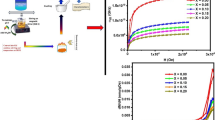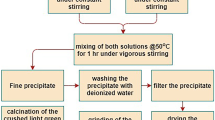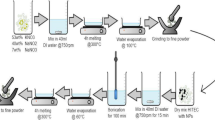An important process task is to expand the range of raw materials applied for the synthesis of dysprosium titanate (neutron-absorbing material for VVER-1000 reactors) and to establish and optimize methods for producing powders and pellets with characteristics that meet specific technical requirements, primarily those for the density and structural and phase compositions of the materials. The influence of MoO3 doping additions and TiO2 powders with different particle sizes on the density and phase composition of dysprosium titanate (Dy2O3 · TiO2) pellets was experimentally studied. Titanium oxide powders of two grades were used: powder with spherical 10–30 μm particles (OSCh 7-3 grade as per TU 6-09-3811–79) and powder with an average particle size of ~63 nm (China Rare Metal Material Co., China). The nanosized TiO2 powder intensified the sintering of the pellets, which achieved a density of 6.9 g/cm3 and acquired a single-phase hexagonal structure at 1650°C. The coarse TiO2 powder did not promote high density of the sintered pellets, nor did it facilitate complete synthesis of dysprosium titanate since a significant amount of intermediate dysprosium dititanate (Dy2Ti2O7) and initial dysprosium oxide (Dy2O3) remained in the synthesized material. The introduction of MoO3 intensified the sintering of pellets, increased the pellet density up to 6.7 g/cm3, and led to a single-phase cubic structure of pyrochlore type, regardless of the TiO2 powder grade. The simultaneous use of the nanosized TiO2 powder and MoO3 doping addition increased the density of the sintered dysprosium titanate pellets to 7.1 g/cm3 and promoted a single-phase structure of pyrochlore type.





Similar content being viewed by others
References
V.D. Risovany, E.E. Varlashova, and D.N. Suslov, “Dysprosium titanate as an absorber material for control rods,” J. Nucl. Mater., 281, 84–89 (2000).
V.M. Chernishov and I.N. Vasilchenko, “Control members of WWER-440 and WWER-1000 power reactors,” in: Advances in Control Assembly Materials for Water Reactors. Proceedings of a Technical Committee Meeting held in Vienna (29 November–2 December 1993), IAEA-TECDOC-813, pp. 105–119.
V.D. Rysovany, A.V. Zakharov, V.B. Ponomarenko, E.P. Klochkov, and E.M. Muraleva, Dysprosium in Nuclear Engineering [in Ukrainian], SSC RIAR, Dimitrovgrad (2011), p. 224.
Neutron-Absorbing Material. Russian Federation Patent 2142654, IMC 6 G21C7/24, No. 98113738/06 dated July 10, 1998; publ. December 10 (1999).
I.O. Chernov, M.M. Belash, I.V. Kolodiy, Ye.B. Valezhniy, O.S. Kalchenko, and O.O. Slabospitska, “Phase formation and characteristics of dysprosium titanate pellets prepared by solid state synthesis,” Probl. Atom. Sci. Technol., No. 2 (108), 150–155 (2017).
G.V. Shamray, R.L. Magunov, I.V. Stasenko, and A.P. Zhirnova, “The Dy2O3–TiO2 system,” Izv. Akad. Nauk SRSR. Ser. Neorg. Mater., 25, No. 2, 273–275 (1989).
Sinha Amit and B.P. Sharma, “Development of dysprosium titanate based ceramics for control rod applications,” J. Am. Ceram. Soc., 88, No. 4, 1061–1066 (2005).
Author information
Authors and Affiliations
Corresponding author
Additional information
M. M. Belash is deceased
Translated from Poroshkova Metallurgiya, Vol. 62, Nos. 3–4 (550), pp. 153–161, 2023
Rights and permissions
Springer Nature or its licensor (e.g. a society or other partner) holds exclusive rights to this article under a publishing agreement with the author(s) or other rightsholder(s); author self-archiving of the accepted manuscript version of this article is solely governed by the terms of such publishing agreement and applicable law.
About this article
Cite this article
Chernov, I.O., Belash, M.M., Romankov, V.O. et al. Effect of MoO3 and TiO2 Powder Particle Sizes on the Phase Composition and Density of Dysprosium Titanate Pellets. Powder Metall Met Ceram 62, 257–264 (2023). https://doi.org/10.1007/s11106-023-00390-5
Received:
Published:
Issue Date:
DOI: https://doi.org/10.1007/s11106-023-00390-5




